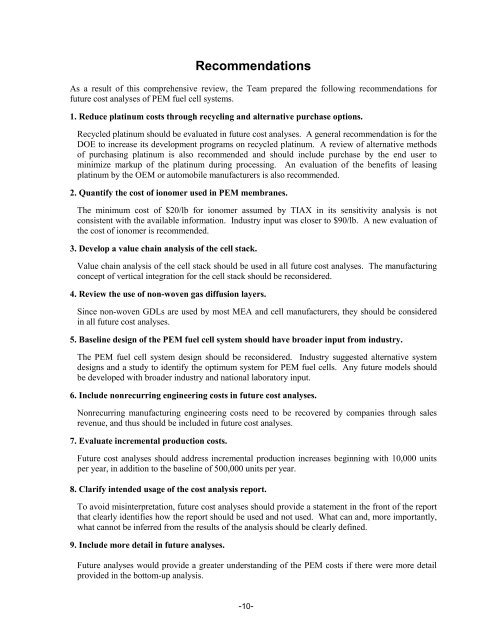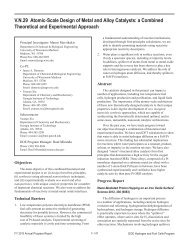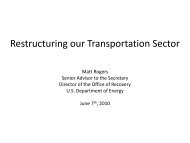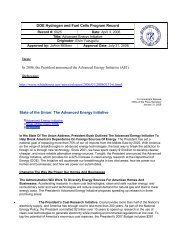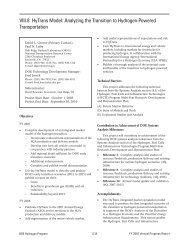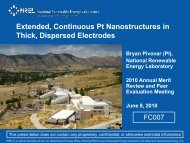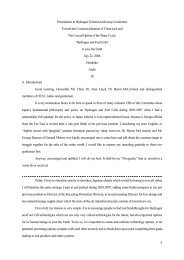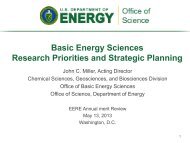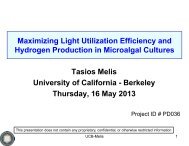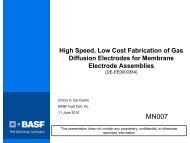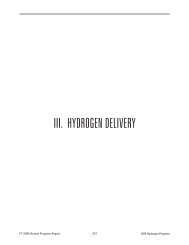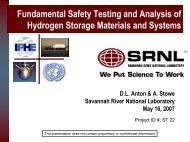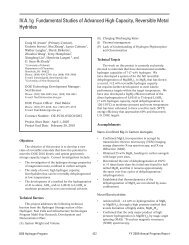Fuel Cell System for Transportation -- 2005 Cost Estimate
Fuel Cell System for Transportation -- 2005 Cost Estimate
Fuel Cell System for Transportation -- 2005 Cost Estimate
Create successful ePaper yourself
Turn your PDF publications into a flip-book with our unique Google optimized e-Paper software.
Recommendations<br />
As a result of this comprehensive review, the Team prepared the following recommendations <strong>for</strong><br />
future cost analyses of PEM fuel cell systems.<br />
1. Reduce platinum costs through recycling and alternative purchase options.<br />
Recycled platinum should be evaluated in future cost analyses. A general recommendation is <strong>for</strong> the<br />
DOE to increase its development programs on recycled platinum. A review of alternative methods<br />
of purchasing platinum is also recommended and should include purchase by the end user to<br />
minimize markup of the platinum during processing. An evaluation of the benefits of leasing<br />
platinum by the OEM or automobile manufacturers is also recommended.<br />
2. Quantify the cost of ionomer used in PEM membranes.<br />
The minimum cost of $20/lb <strong>for</strong> ionomer assumed by TIAX in its sensitivity analysis is not<br />
consistent with the available in<strong>for</strong>mation. Industry input was closer to $90/lb. A new evaluation of<br />
the cost of ionomer is recommended.<br />
3. Develop a value chain analysis of the cell stack.<br />
Value chain analysis of the cell stack should be used in all future cost analyses. The manufacturing<br />
concept of vertical integration <strong>for</strong> the cell stack should be reconsidered.<br />
4. Review the use of non-woven gas diffusion layers.<br />
Since non-woven GDLs are used by most MEA and cell manufacturers, they should be considered<br />
in all future cost analyses.<br />
5. Baseline design of the PEM fuel cell system should have broader input from industry.<br />
The PEM fuel cell system design should be reconsidered. Industry suggested alternative system<br />
designs and a study to identify the optimum system <strong>for</strong> PEM fuel cells. Any future models should<br />
be developed with broader industry and national laboratory input.<br />
6. Include nonrecurring engineering costs in future cost analyses.<br />
Nonrecurring manufacturing engineering costs need to be recovered by companies through sales<br />
revenue, and thus should be included in future cost analyses.<br />
7. Evaluate incremental production costs.<br />
Future cost analyses should address incremental production increases beginning with 10,000 units<br />
per year, in addition to the baseline of 500,000 units per year.<br />
8. Clarify intended usage of the cost analysis report.<br />
To avoid misinterpretation, future cost analyses should provide a statement in the front of the report<br />
that clearly identifies how the report should be used and not used. What can and, more importantly,<br />
what cannot be inferred from the results of the analysis should be clearly defined.<br />
9. Include more detail in future analyses.<br />
Future analyses would provide a greater understanding of the PEM costs if there were more detail<br />
provided in the bottom-up analysis.<br />
-10-


